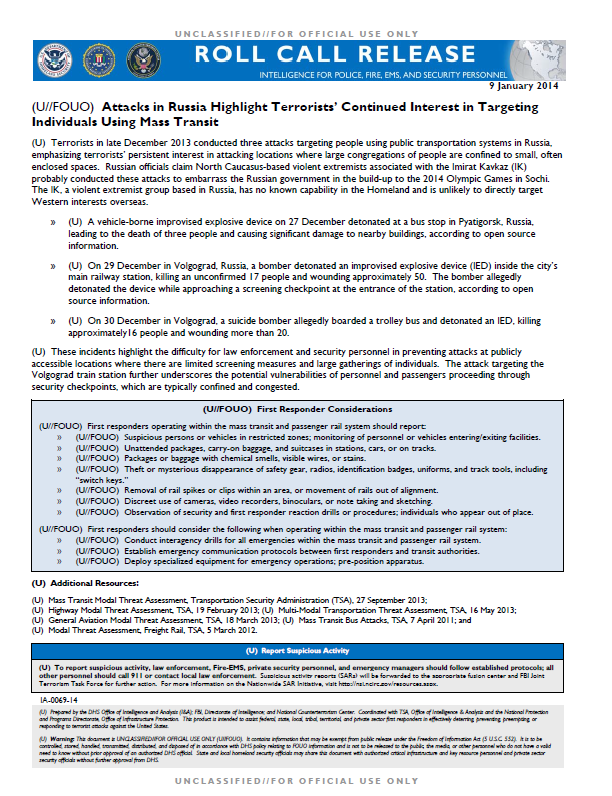Attacks in Russia Highlight Terrorists’ Continued Interest in Targeting Individuals Using Mass Transit
- 1 page
- For Official Use Only
- January 9, 2014
(U) Terrorists in late December 2013 conducted three attacks targeting people using public transportation systems in Russia, emphasizing terrorists’ persistent interest in attacking locations where large congregations of people are confined to small, often enclosed spaces. Russian officials claim North Caucasus-based violent extremists associated with the Imirat Kavkaz (IK) probably conducted these attacks to embarrass the Russian government in the build-up to the 2014 Olympic Games in Sochi. The IK, a violent extremist group based in Russia, has no known capability in the Homeland and is unlikely to directly target Western interests overseas.
» (U) A vehicle-borne improvised explosive device on 27 December detonated at a bus stop in Pyatigorsk, Russia, leading to the death of three people and causing significant damage to nearby buildings, according to open source information.
» (U) On 29 December in Volgograd, Russia, a bomber detonated an improvised explosive device (IED) inside the city’s main railway station, killing an unconfirmed 17 people and wounding approximately 50. The bomber allegedly detonated the device while approaching a screening checkpoint at the entrance of the station, according to open source information.
» (U) On 30 December in Volgograd, a suicide bomber allegedly boarded a trolley bus and detonated an IED, killing approximately16 people and wounding more than 20.
(U) These incidents highlight the difficulty for law enforcement and security personnel in preventing attacks at publicly accessible locations where there are limited screening measures and large gatherings of individuals. The attack targeting the Volgograd train station further underscores the potential vulnerabilities of personnel and passengers proceeding through security checkpoints, which are typically confined and congested.
(U//FOUO) First Responder Considerations
(U//FOUO) First responders operating within the mass transit and passenger rail system should report:
» (U//FOUO) Suspicious persons or vehicles in restricted zones; monitoring of personnel or vehicles entering/exiting facilities.
» (U//FOUO) Unattended packages, carry-on baggage, and suitcases in stations, cars, or on tracks.
» (U//FOUO) Packages or baggage with chemical smells, visible wires, or stains.
» (U//FOUO) Theft or mysterious disappearance of safety gear, radios, identification badges, uniforms, and track tools, including “switch keys.”
» (U//FOUO) Removal of rail spikes or clips within an area, or movement of rails out of alignment.
» (U//FOUO) Discreet use of cameras, video recorders, binoculars, or note taking and sketching.
» (U//FOUO) Observation of security and first responder reaction drills or procedures; individuals who appear out of place.(U//FOUO) First responders should consider the following when operating within the mass transit and passenger rail system:
» (U//FOUO) Conduct interagency drills for all emergencies within the mass transit and passenger rail system.
» (U//FOUO) Establish emergency communication protocols between first responders and transit authorities.
» (U//FOUO) Deploy specialized equipment for emergency operations; pre-position apparatus.

